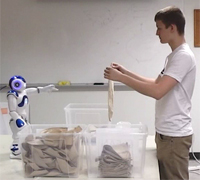« Back to Publications list
Investigating People’s Rapport Building and Hindering Behaviors When Working with a Collaborative Robot
Download Publication File
Abstract
Modern industrial robots are increasingly moving toward collaborating with people on complex tasks as team members, and away from working in isolated cages that are separated from people. Collaborative robots are programmed to use social communication techniques with people, enabling human team members to use their existing inter-personal skills to work with robots, such as speech, gestures, or gaze. Research is increasingly investigating how robots can use higher-level social structures such as team dynamics or conflict resolution. One particularly important aspect of human–human teamwork is rapport building: these are everyday social interactions between people that help to develop professional relationships by establishing trust, confidence, and collegiality, but which are formally peripheral to a task at hand. In this paper, we report on our investigations of how and if people apply similar rapport-building behaviors to robot collaborators. First, we synthesized existing human–human rapport knowledge into an initial human–robot interaction framework; this framework includes verbal and non-verbal behaviors, both for rapport building and rapport hindering, that people can be expected to exhibit. We developed a novel mock industrial task scenario that emphasizes ecological validity, and creates a range of social interactions necessary for investigating rapport. Finally, we report on a qualitative study that investigates how people use rapport hindering or building behaviors in our industrial scenario, which reflects how people may interact with robots in industrial settings.
Publisher Link
https://link.springer.com/article/10.1007%2Fs12369-017-0441-8
Citation
Stela H. Seo, Keelin Griffin, James E. Young, Andrea Bunt, Susan Prentice, Veronica Loureiro-Rodríguez. "Investigating people’s rapport building and hindering behaviors when working with a collaborative robot," International Journal of Social Robotics, 2018. Springer.
https://doi.org/10.1007/s12369-017-0441-8

Authors

Stela Hanbyeol Seo
Alumni
James E.Young
Professor
Andrea Bunt
ProfessorAs well as: Keelin Griffin and Susan Prentice and Verónica Loureiro-Rodríguez

